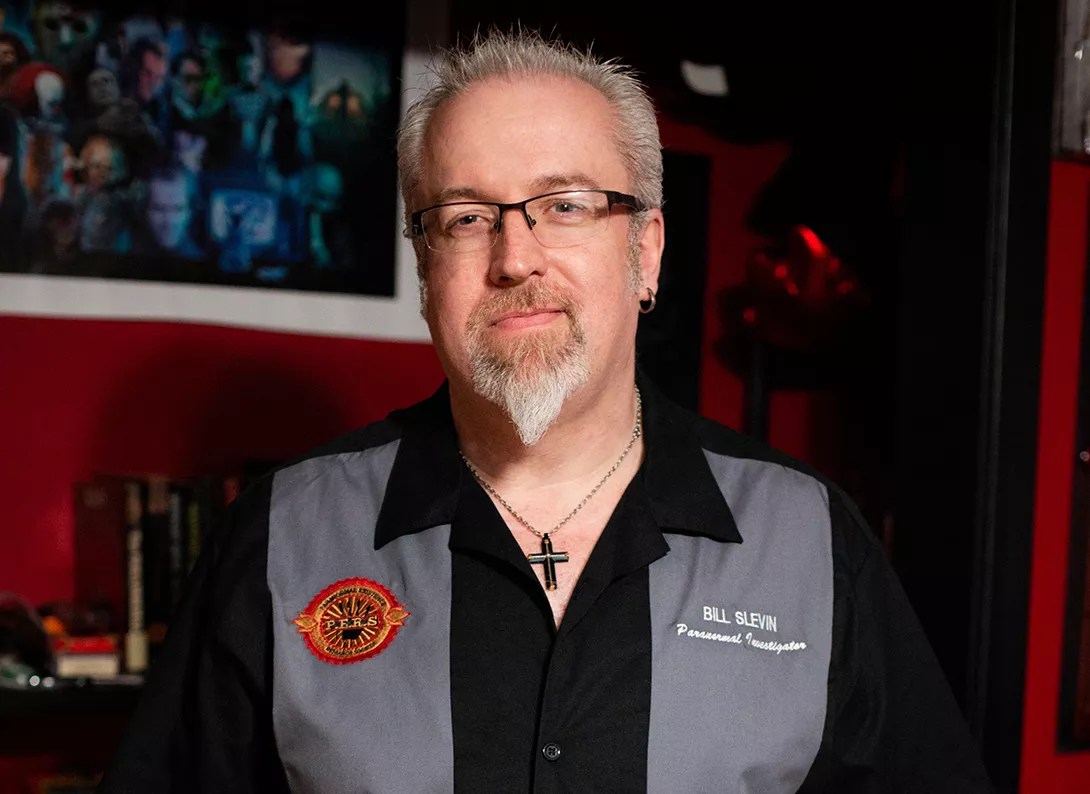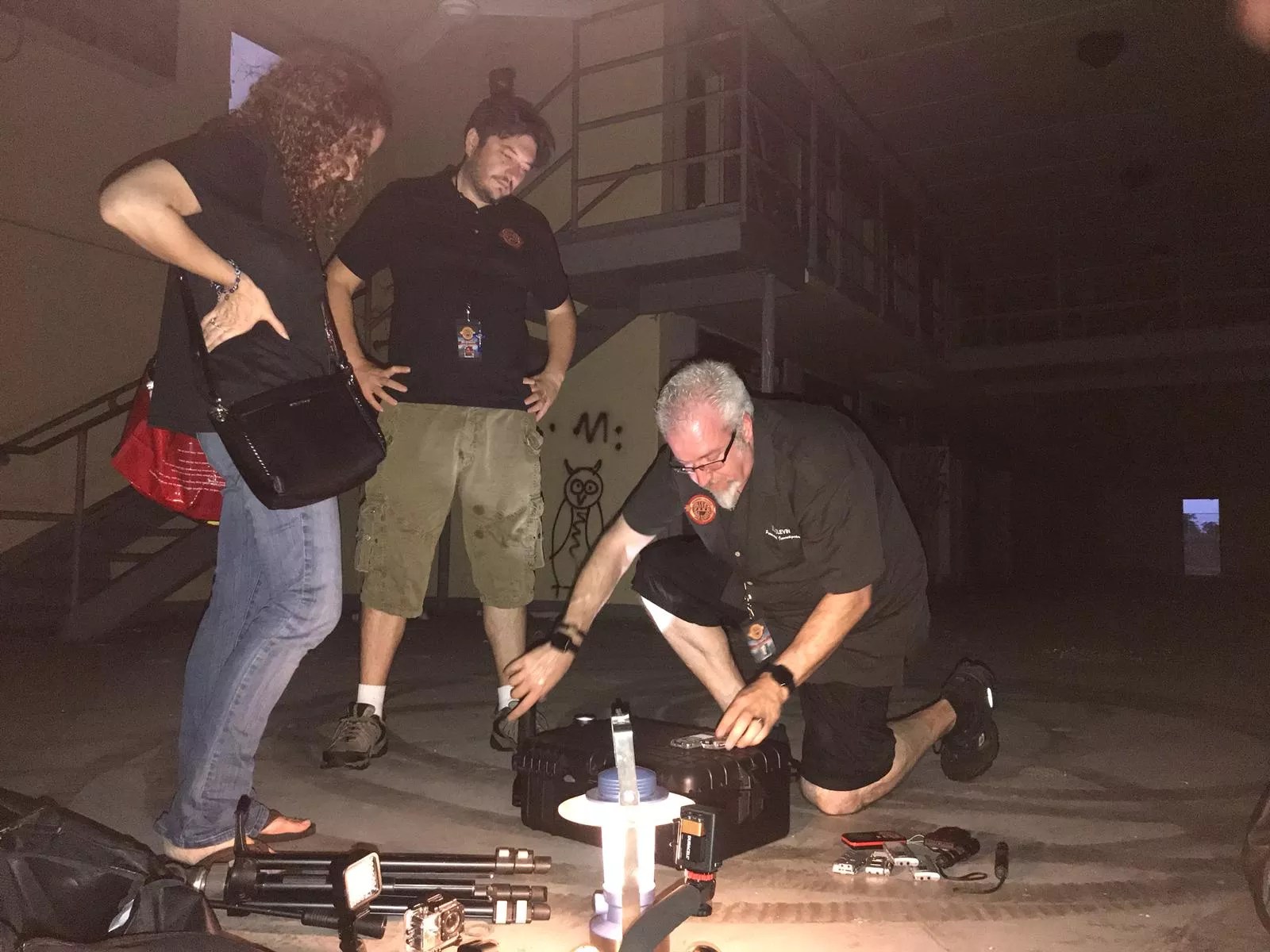
Bill Slevin photo

Audio By Carbonatix
When world-famous paranormal investigator Bill Slevin spoke during our interview about ghosts and demons, the recording device on my computer started to skip around. Listening back on our conversation, portions became fuzzy, especially as he spoke about exorcisms. The hair stood up on my neck, but the Coral Springs resident was such a compelling storyteller that it was hard to stop chatting.
Slevin has been investigating these unknown forces for 35 years but has experienced paranormal events his whole life. Growing up in the 1970s and ’80s, nobody talked about supernatural things. “I never knew what an empath was. I just knew I would go places and feel weird things,” he recalls. As an empath, he felt other people’s emotions and sometimes carried them with him. As a kid, he was also into horror movies and was never scared – except when he saw The Exorcist.
He was curious about paranormal experiences and started to research everything he could about them. He went on to get his PhD in parapsychology and metaphysical humanistic science and has studied quantum physics and mechanics.
The first of his more than 1,000 residential haunting jobs was in 1989. A friend brought him in on a frightening investigation. “Demons are very rare; it’s not like TV,” he says. “It happened to be a rare demonic case. The guy with me got full-on attacked. That team never did this again, but it gave me a million questions.” He realized this was his calling. “I really wanted to know what was real and what was not,” Slevin says.
Will you step up to support New Times this year?
At New Times, we’re small and scrappy — and we make the most of every dollar from our supporters. Right now, we’re $16,750 away from reaching our December 31 goal of $30,000. If you’ve ever learned something new, stayed informed, or felt more connected because of New Times, now’s the time to give back.

Slevin makes the rounds at HorrorCons, libraries, and on TV to share his knowledge and experiences — especially during the Halloween season.
Brittany Fournier photo
He and his team at the nonprofit Paranormal Existence Research Society (PERS) are based out of Coral Springs, with teams in other Florida cities, Georgia, Nebraska, the UK, Italy, and Greece. They don’t charge people for their work – it’s all free – but if someone out of state wants to work with them, they will let them pay for travel. “We don’t feel it’s ethical [to charge] because it’s not 100 percent science.” His team is a diverse group of talents and includes a Peruvian shaman, hypnotherapist, licensed psychologist, mediums, and psychics.
“We’re a mix of intuition and science,” he says. “We help these people no matter what.” That includes people who are suffering from mental illness or substance use issues. Slevin works a day job as an IT director for a psychiatric drug and alcohol treatment facility, which has provided him with the knowledge to identify when clients are suffering from these issues and not an actual haunting.
When they first get asked to investigate, the team interviews the clients. If they take the case, they go to the homes at night using a combination of his empath abilities and certain devices. “Being IT and paranormal – a very bad mix,” he jokes. “I have a ridiculous amount of equipment.” They experiment with audio and video tools and observe environmental cues with a healthy amount of skepticism. They first assess to see if there are natural causes for the experiences of the clients, like animals in the walls, and they determine if it’s a case of the paranormal.
“Everything is energy. When you die, your energy doesn’t die. Energy can’t be destroyed or created,” he says. The most common thing his team finds is residual hauntings, in which a person leaves behind energy. He remembers a haunting incident in New Jersey when a client in an old house said that every day at 7 p.m., they heard footsteps up the stairs. The team heard them but couldn’t connect with a spirit. It was likely, he says, a “footprint” left by someone who passed that walked there daily. The solution? To cleanse the area is something his team teaches people to do for themselves. “Anybody can wave sage around the house, and it’s not going to do anything. It’s your intention [that matters],” and even then, energy can return.
To cleanse or protect themselves and their clients, they respect the religious and spiritual beliefs of the people they’re helping. If someone is Jewish, for instance, they won’t come in waving crucifixes. Unless, that is, if they suspect it’s a demonic entity, then they’ll use everything in their arsenal to protect themselves.
It’s usually not anything that sinister. Even funky energy from living clients can cause hauntings. “Sometimes people can watch five hours of Ghost Adventures, and now they’re panicked, and they can actually manifest stuff to the house. It might not be real.” He says parapsychology studies have shown that “a lot of Poltergeist activity is caused by teenagers. That their energy shift is so strong, especially females, that it can actually make things move,” he says. “It’s not going to pick up a couch and throw it across the room.”
In South Florida, you may not have very old houses, but there are a lot of Indigenous American burial grounds. He used to bring new members of his team to Belgrade, Florida, where there was a 280-acre abandoned prison in the middle of a sugarcane field. “Because you can say you’re into this, but when you’re in an abandoned prison at two o’clock in the morning, there’s a lot of activity in that place,” he says. There’s now a warehouse built in that spot. “If they’d built houses there, I’d be going door to door to drop off my card.”

Slevin uses every device and method in his and his team’s toolbox to find out what’s really going down.
Bill Slevin photo
Slevin educates the public about issues related to the supernatural. He’s the director and manager of the Warren Legacy Foundation for Paranormal Research, founded by Lorraine Warren and Chris McKinnell, the grandson of Ed and Lorraine Warren, who investigated the Amityville haunting. He speaks as a celebrity guest at conferences and has appeared on TV, radio, podcasts, magazines, and newspapers. He’s been on the cover of American Paranormal magazine five times.
He also spoke about demonology on the Travel Channel documentary The Devil’s Academy, which also streams on Discovery+ and Max. It explores a possible mass possession at the Miami Aerospace Academy High School in 1970. Students ripped doors off the hinges, one girl levitated, and another boy jumped out of the second-floor window unscathed, landing face-first on the concrete and then threw the security guard across the parking lot. The interviewing process unnerved him because when the producers asked specific demonology questions, he didn’t want to share any misinformation with the public. He says they’re very real but very rare.
Slevin will speak at upcoming events at the Coconut Grove and Coral Springs libraries. At his library shows, you can hear more of Slevin’s spooky stories, learn about haunted places in South Florida, and see evidence that the paranormal is actually quite normal.
Bill Slevin. 3 to 5 p.m. Saturday, October 26, Coconut Grove Branch Library, 2875 McFarlane Rd., Coconut Grove; and 2 to 4 p.m. Saturday, November 9, Northwest Regional Library, 3151 N. University Dr., Coral Springs; billslevin.com. Admission is free.